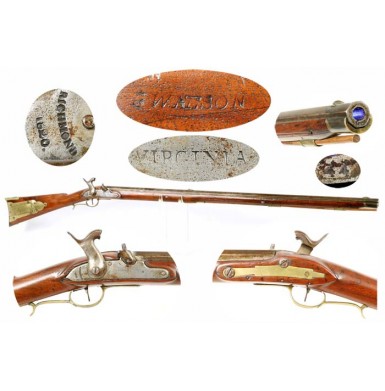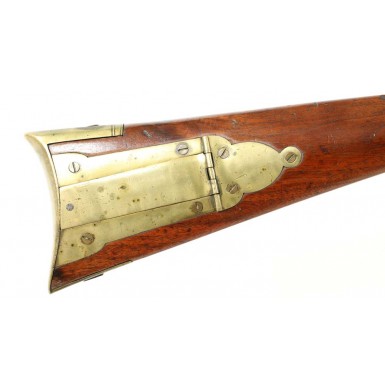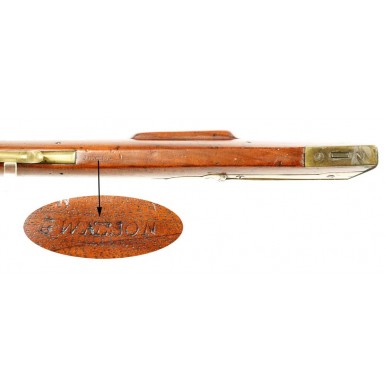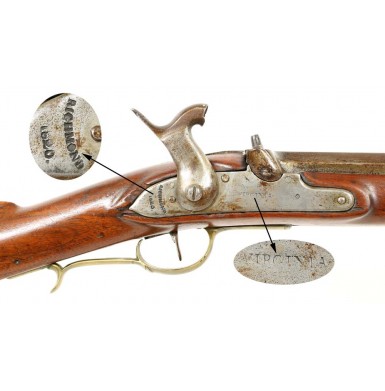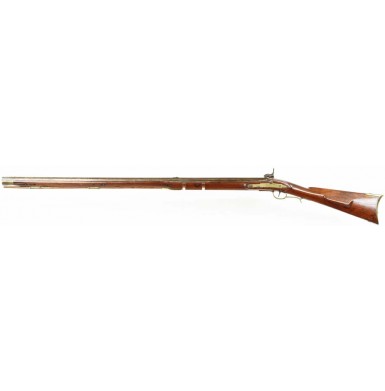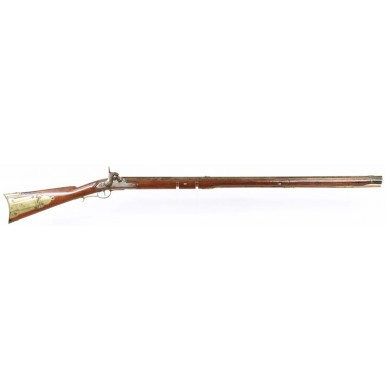Confederate Altered Virginia Manufactory Rifle
- Product Code: FLA-3372-SOLD
- Availability: Out Of Stock
-
$1.00
By an act of the Virginia legislature, the Virginia Manufactory of Arms was established in 1797. The goal of this armory, located along the James River in Richmond, was to supply the Virginia militia with the required arms for the defense of the Commonwealth. Over a roughly two-decade period, from 1802 through 1821, the Virginia Manufactory produced a variety of small arms, including some 58,000 flintlock muskets, 4,000 flintlock pistols, 2,000 flintlock rifles, and some 10,000 sabers. The facility also produced about 300 canons during this period. Although the facility was shut down circa 1821, primarily because arms were forthcoming from the US government under the Militia Act of 1808, it was resurrected during the Civil War period as the Richmond Manufactory. In the interim the facility served as an arsenal (storage facility), rather than an armory (manufactory). In 1860, with the clouds of war looming, the Commonwealth decided to return the facility to its prior manufacturing status. To perform this task former Harpers Ferry Master Armorer James Burton was hired to set up the facility. Burton had just returned from overseeing the set-up of the British Royal Small Arms Factory (RSAF) at Enfield Lock, Great Britain's version of the "Springfield Armory" and was undertaking to receive the necessary machinery to manufacture rifle muskets in Richmond when the Civil War erupted.
The reestablishment of the Virginia Manufactory as the new Richmond Arsenal was not the only action that the Virginia government took to prepare for war. In addition to trying to acquire small arms from as many vendors as possible during the year leading up to the firing on Fort Sumter, a major program of improvement was undertaken to alter existing stocks of flintlock firearms to percussion. This had actually been going on somewhat aggressively since about 1857, when the Commonwealth had started to turn in as many flintlock muskets as the Federal Government would allow under the Militia Act of 1808, to have them replaced by percussion altered muskets. The Commonwealth had also contacted some private vendors like Merrill, Thomas & Company prior to the war, to alter existing stocks of arms to percussion, primarily Virginia Manufactory arms that were in store. Once the war broke out the Commonwealth relied on additional contractors to continue the percussion alteration program. The primary contractors were Thomas J. Adams of Richmond, J.B. (and A.B.) Barrett & Company, William Morgan, F. Persignon, S.C. Robinson and the Union Manufacturing Company. Three smaller contractors also did alterations for the Commonwealth on a much more limited basis, including J.H. Wells, J.D. Brown and S. Holbrook. While the majority of this work was performed on flintlock muskets, many of the remaining stocks of flintlock Virginia Manufactory rifles and pistols were altered to percussion as well.
During 1803 the Virginia Manufactory had produced its first flintlock rifles. These "First Model" or "Type I" rifles largely followed the pattern of the "Kentucky" or "Pennsylvania" rifles then in common use on the frontier. They were nominally .50 rifles with octagonal barrels that were initially 46" in length but were changed to 43" in length in 1806. The guns were 62" in overall length (1803-1805) and then 58 “" in overall length. They were full stock, did not accept a bayonet and were brass mounted during early production, but were changed to iron mounted during 1806. The most notable visual feature of these early rifles was a large, four-piece patchbox in the obverse buttstock that terminated in a large coiled snake hinge plate. Only 333 of these very scarce "snake patchbox" rifles were produced by the Virginia Manufactory from 1803 through 1809. The production of "Second Model" or "Type II" Virginia Manufactory Rifles began circa 1810-1811, but no rifles were completed until 1812. These rifles were very similar to the earlier "Type I" guns, but were .45 caliber, with a nominally 39" (38 13/16") octagonal barrel and an overall length of 55". The barrel was secured with three keys and screw through the breech plug tang. Like the preceding rifle it was a flintlock muzzleloader, and like the earliest "Type I" rifles, was brass mounted. Again, the design incorporated a full stock with no provision for a bayonet. US tactical doctrine of the period saw the rifle as a specialty weapon and they were not generally equipped with bayonets. Instead of the "Snake Patchbox" a more conventionally shaped four-piece brass patchbox was incorporated in the obverse buttstock. Between 1812 and 1821, a total of 1,760 of the Second Model Virginia Manufactory Rifles were produced, bringing the total rifle production of the Virginia Manufactory to 2,093. Between 1809 and 1815, the Commonwealth also purchased some contract rifles, and did so again in 1819. These contract rifles were quite similar to the current production Second Model Rifles, and a total of 2,145 were so acquired. Thus, the Commonwealth of Virginia manufactured or purchased a total of 4,238 flintlock rifles between 1803 and 1821. According to George Moller's research, between 1,000 and 1,500 of these flintlock rifles remained in storage throughout the Commonwealth in 1860.
One of the largest pre-war operations to alter Virginia Manufactory Rifles from flint to percussion was undertaken during the fall of 1858 and the Spring of 1859. Some 600 Virginia Manufactory Rifles were forwarded to the Washington Arsenal to be so altered, but only 32 were modified. The balance of the rifles were then shipped to Harpers Ferry, where in early 1859 hammers and jigs were produced to perform the alterations, and the balance of the guns were altered and then returned to the Richmond Arsenal. The cost of the work by the US Ordnance Department was charged against Virginia's yearly allotment of arms under the Militia Act of 1808, and the effective "cost" of the work equated to a deduction of some 44 muskets from the Commonwealth's yearly allotment. As a result of the John Brown Raid on Harpers Ferry on October 16, 1859, nearly all of these rifles were issued to the Virginia Militia. The raid likely induced the Commonwealth to look to other potential locations to have the stock of flintlock rifles altered. One company that the Commonwealth turned to was Merrill, Thomas & Company of Baltimore.
Merrill, Thomas & Company had formerly been the firm of Merrill, Latrobe & Thomas and had manufactured the Merrill, Latrobe & Thomas breechloading carbine for the US military (c1855) and would go on to manufacture Merrill breechloading carbines and rifles for the Union during the American Civil War. The firm agreed to undertake the alteration process at a cost of $2 per rifle, plus shipping and packing costs. Between 250 and 360 of the rifles were forwarded to Merrill in Baltimore for alteration in early 1861, one group of guns consisting of 172 rifles, was returned April 17, 1861; less than a week after the firing on Fort Sumter. The work is distinctly identifiable as Merrill's, as the percussion bolster and hammer are both of the same profile found on the Merrill patent carbines and rifles. The oblong, angled bolster included a clean out screw and was brazed over the original flintlock vent hole. The external flintlock battery was removed, and the associated lock holes filled. A percussion hammer of Merrill's design was added to the tumbler, and the percussion alteration process was complete. An additional feature of the Merrill altered rifles was that the barrels were cut back slightly from their original 39" length to between 36" and 36 “". A number was then stamped on the face of the muzzle, which is believed to be an alteration inventory number, to keep track of the number of guns altered and to be billed for.
According to the research in Confederate Rifles and Muskets by Dr. John D. Murphy and Howard M. Madaus, at least 270 of the Merrill altered Virginia Manufactory Rifles can be documented as being issued between April 1, 1861 and June 13, 1861. The issuances of the guns are as follows:
"50 Virginia Altered Rifles to Captain W.W. Cogbill, Chesterfield" this is believed to be W.T. Cogbill of the "Chesterfield Central Guards", who would go on to be Company D of the 14th Virginia Infantry.
"60 Altered Virginia Rifles to Captain S.S. Williams, Woodstock." This appears to be Samuel C. Williams of the "Brooklyn Grays", who would go on to be Company F of the 10th Virginia Infantry.
"100 Virginia Altered Percussion Rifles to M.J. Harman, Staunton." This appears to be Quartermaster M.G. Harman of Staunton, who subsequently issued the guns to the regiment being assembled by Colonel George A. Porterfield, which would become the 25th Virginia Infantry.
"10 Virginia Percussion Rifles to Captain J.W. Timberlake, Greenwood Depot." These guns went to the "Albemarle Rangers".
"12 Virginia Percussion Lock rifles to Captain Thomas G. Pollock" for issue to the "Wise Skirmishers". Captain Pollock was a company commander in the 46th Virginia Infantry, who would later go on to serve on the staff of General Kemper and be killed at Gettysburg.
While other issues of "Virginia Rifles" are noted, the references make it impossible to determine if the guns were percussion altered or remained in their original flintlock configuration. Using George Moller's research as a point of reference, when the war broke out, approximately 700 to 1,200 Virginia Rifles remained in store in their flintlock configuration after deducting the Merrill altered rifles from his 1860 figure. Many of these guns were subsequently altered to percussion by Virginia based contractors, like those listed earlier in this discussion.
Offered here is a VERY GOOD+ example of a Merrill Altered 2nd Model Virginia Manufactory Rifle. The gun conforms in all ways to the handful of known examples that survive today. The rifle has the expected Merrill pattern hammer and bolster, and the barrel has been shortened from a nominal 39" to 36 “". The face of the muzzle is numbered 44. Interestingly, the only Merrill altered Virginia Manufactory Rifle available for the Murphy & Madaus study was 46, only two numbers away from this example. The rifle is clearly marked on the lock in a horizontal arc behind the hammer RICHMOND, over the date 1820. According to surviving inventory records, only 200 of the 2nd Model VA. Manufactory Rifles were produced in that year. Forward of the hammer, the lock is stamped VIRGINIA, although this mark is not nearly as deep and crisp as the markings behind the hammer. The only other external mark is the name E WATSON (possibly "G" Watson) stamped in the wood along the toe line behind the triggerguard. An examination of Confederate enlistment rolls show both an "E" and "G" Watson served in the 46th Virginia Infantry, a regiment that was issued 12 of these rifles via Captain Pollock, who used them for a small group of skirmishers. Further research may be fruitful in determining if this rifle was carried by one of these men in the performance of their duty with the "Wise Skirmishers" of the 46th Virginia Infantry.
The rifle remains in solid original condition, with some expected wear and tear and a couple of minor repairs and replacement parts. The octagonal barrel retains strong edges and is crisp throughout, with a mottled, oxidized brown over gray patina, some scattered pinpricking and some lightly scattered pitting. The lock has been lightly cleaned and has a more pewter patina. The lock remains fully functional and works crisply on all positions. The clean out screw in the Merrill bolster is original but damaged, with the screw head mostly deformed. The hammer nose shows some battering around its skirt and the cone (nipple) is a more recent replacement; although it appears to be a period cone. The rifle retains a fixed, dovetailed, period rear sight and a relocated period dovetailed brass blade front sight. The moving of the front sight was necessitated by the shortening of the barrel during the Merrill alteration. The bore of the rifle remains in GOOD to NEAR VERY GOOD condition. It retains strong rifling its entire length but is dark and dirty and shows moderate pitting throughout. All of the brass furniture is original to the rifle and remains in nice condition. The brass appears to have been lightly cleaned at some point and is dulling down to an attractive dull golden patina. The patchbox release appears to have had an old internal mechanical repair to make it functional again, but this is not visible from the exterior. The stock of the rifle remains in about GOOD+ condition and is not quite as nice as the metal. The stock appears to have been lightly sanded at some point, and like most "long rifles" shows some splintering and wood along the top edge of the thin forend. There is some wood loss behind the lock and an old repaired crack running from the upper rear edge of the lock to the breech plug tang. A couple of old grain cracks are present in the forend as well, but these are tight and not structural issues. About 1 “" of the stock tip has been repaired and replaced at some point in time. The sheet brass nosecap is an equally old replacement, but shows a nice, aged patina. The wood ramrod is an incorrect replacement, as is so often the case on antique "long rifle" firearms.
Overall this is a very nice example of an extremely rare Confederate altered, Virginia produced rifle. With only 2,000 Virginia Manufactory Rifles of all patterns being produced, and with no more than 360 of the guns being altered to percussion by Merrill, this is a very scarce gun. Most estimations place surviving examples at around a half-dozen, with only four known to me personally. For any serious collector of Virginia Civil War arms, this is an extremely rare piece that belongs in an advanced collection. The fact that the gun may be identified to a member of the 46th Virginia Infantry only enhances its historical importance even more. I am quite certain you will be very pleased adding this rare rifle to your collection of Confederate long arms.
SOLDTags: Confederate, Altered, Virginia, Manufactory, Rifle

